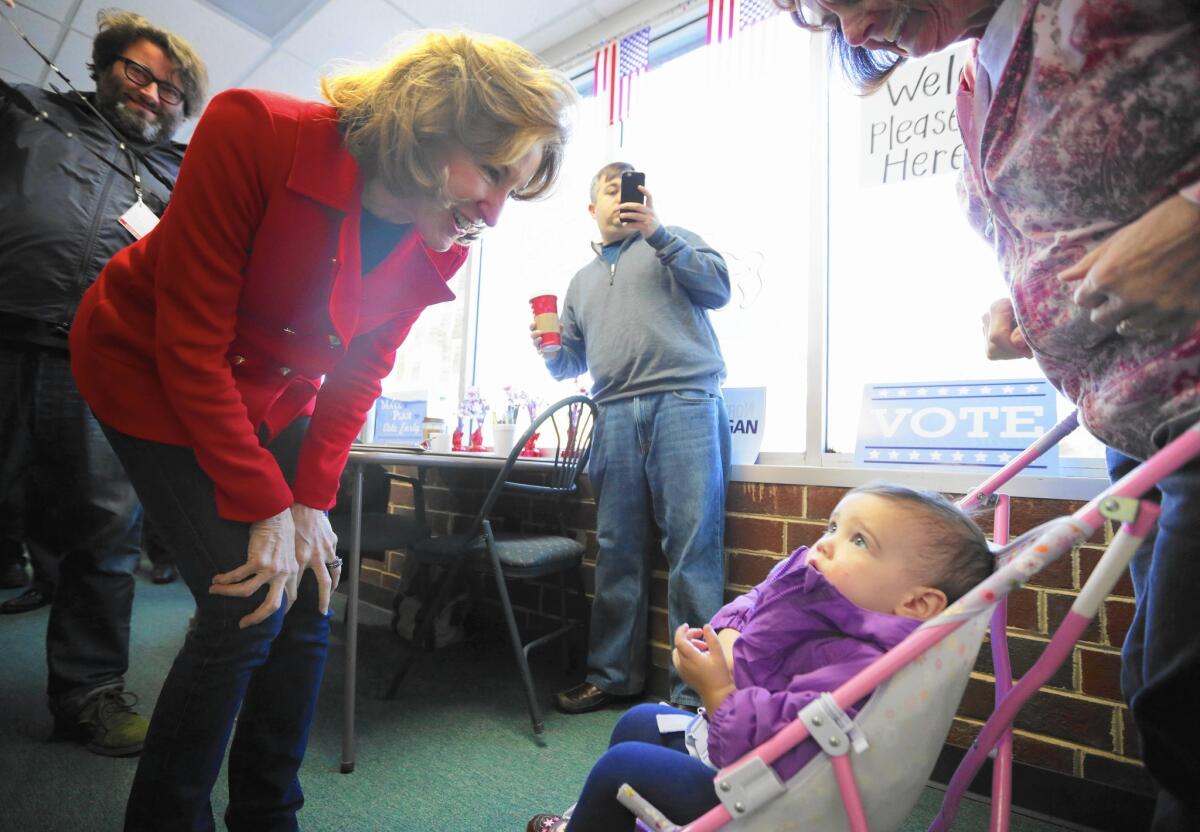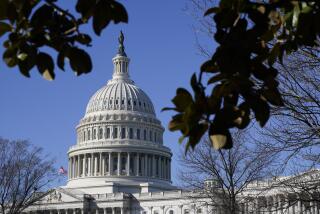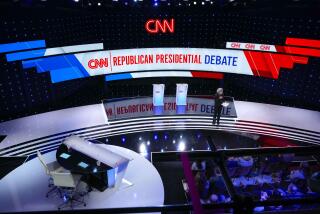Midterm ad blitz marks new era in political spending

For months, a billion-dollar ad blitz has flooded the airwaves here and in other closely contested states leading up to Tuesday’s midterm election, another sign that the nation has entered a new era in political spending driven less by candidates and more by outside groups and their deep-pocketed donors.
In North Carolina alone, groups supporting Democratic Sen. Kay Hagan and Republican challenger Thom Tillis have spent more than $72 million, and television stations aired close to 100,000 political commercials — two-thirds of them negative. At $107 million and counting, according to the Sunlight Foundation, the campaign is the most expensive Senate race ever.
North Carolina and three other states that could decide which party controls the Senate — Colorado, Iowa and Georgia — saw a late surge of spending from outside groups over the last week totaling $26.5 million, according to the Campaign Finance Institute.
“The money is shifting away from candidates and toward outside groups,” said Sheila Krumholz, executive director of the Center for Responsive Politics. “It is still really hard to raise contributions for candidates, so you see the attraction of having someone who will come in and bankroll the campaign effort, albeit from the outside, and take the low road.”
Such outside groups are unencumbered by disclosure rules and are increasingly supplanting campaign committees controlled by candidates in setting the tone of campaigns. Experts say the continuing shift to “super PAC” spending is the most important development to emerge in this election, in which close to $4 billion is expected to be spent, a record.
Another trend is a sudden spurt in the number of outside groups that support or attack a single candidate. And Democrats, who have spent the last four years denouncing the flood of outside money to Republicans, have learned to play the game.
Taken together, the trends show how the system of paying for elections continues its rapid transformation since such Supreme Court decisions as Citizens United in 2010, which removed limits on how much corporations could contribute to outside spending groups.
Spending by candidates themselves is projected to fall slightly compared with the midterm election in 2010. That year, campaigns spent $780 million. This time, the number will reach only $636 million, according to new projections by the Center for Responsive Politics, a nonpartisan group that tracks political spending.
Likewise, House candidates will spend about $945 million, down from $1 billion four years ago.
But super PACs, politically focused nonprofits and other outside groups will spend at least $689 million, more than double the amount they spent in 2010, with most of the money coming from big donors, often secretly, the CRP found.
Even those numbers tell only a fraction of the story: So-called dark money groups that don’t have to report much of their spending have been big players in this election.
This year has also seen the rise of single-candidate outside groups, which can raise unlimited amounts of money, unbound by the contribution limits that apply to candidates. There are 92 such groups active this year, Krumholz said. Although they aren’t supposed to coordinate with candidates, the rules are vague and enforcement weak.
The groups make it easier for wealthy donors to give vast sums to get access to politicians, said Michael Malbin, executive director of the Campaign Finance Institute. Most of the groups help incumbents, he said — undercutting the notion that outside spending is important to shake up the status quo.
“The supposedly renegade outside groups are actually being turned into tools for allies of incumbents to help them stay in office,” he said. “It looks like in some cases, it’s not challenging power, it’s reinforcing it.”
The deluge of ads that flooded North Carolina can also be seen in other close states such as Iowa, Kentucky and particularly Colorado, where Denver viewers were pounded with more than 13,000 ads over two weeks in late September and early October — nearly twice as many as any other market in the nation, according to the Wesleyan Media Project.
One ad in Colorado’s neck-and-neck governor’s race implied that incumbent John Hickenlooper was partly to blame for the killing of the state’s prison chief by a paroled inmate; the ad was changed after the man’s widow protested.
During their last debate, Hickenlooper and his Republican challenger, Bob Beauprez, blamed each other for the nasty ad war.
“I denounce all the negative ads. I’m happy to do it,” Hickenlooper said.
“But you’re also happy to let other people do your dirty work for you,” Beauprez said, mentioning negative ads run by the Democratic Governors Assn. Like all candidates, Hickenlooper can’t coordinate with such outside groups.
In the last two elections, Republican-leaning outside groups vastly outspent the Democrats. The role of free-spending conservatives like the wealthy Koch brothers has been a favorite theme for Democrats this year, in campaign ads and in angry speeches from Sen. Harry Reid, the Senate majority leader, denouncing “shadowy billionaires [who] pour unlimited money into our democracy to rig the system.”
But one of the biggest spenders this cycle is the Senate Majority PAC, closely tied to Reid himself. It has spent nearly $47 million this year, mostly to attack Republicans. Nearly a quarter of the money went for attack ads against Tillis.
One North Carolina Democratic consultant, Gary Pearce, said the ads were crucial to helping Hagan by creating a negative image of Tillis, speaker of the state House, where Republicans pushed through spending cuts and other conservative measures.
“It was pretty fertile ground to be plowed, and they got to it early,” Pearce said. “If that’s what the game is, it’s good to know we got it on our side.”
The biggest-spending billionaires this cycle are helping Democrats. The top individual donor this year is Thomas Steyer, the San Francisco hedge fund owner and environmental advocate who has spent $73.7 million to aid Democrats, according to the Sunlight Foundation. Former New York Mayor Michael R. Bloomberg is second with $20 million; he’s an independent but is giving mostly to Democrats.
Still, 15 of the top 20 donors gave to Republicans, led by two hedge fund managers, Paul E. Singer, at $9.3 million, and Robert L. Mercer, at $8 million. Sheldon Adelson, who spent nearly $90 million two years ago, gave $5 million to a super PAC that helps Republicans, although he has reportedly given millions more to other groups that don’t disclose their donors.
After more than $100 million in spending, North Carolina’s Hagan-Tillis race remains a virtual toss-up. An 8-year-old student in Raleigh made news when she wrote a letter to both candidates chiding them for saying so many “mean things about each other.”
Both sides recently began airing ads remarking on how nasty the ads have been.
“If you’d believed all you see on television you’d conclude that Sen. Hagan is a bad person, and that I am too,” Tillis said in one commercial. “It’s a shame.”
Although voters uniformly have said they decry the negativity, one expert says there’s no sign they will stay home as a result.
Early voting has been robust, said Michael McDonald, a political science professor at the University of Florida who studies election turnout. He’s projecting that overall turnout in the most competitive Senate states will exceed the levels of 2010.
More to Read
Get the L.A. Times Politics newsletter
Deeply reported insights into legislation, politics and policy from Sacramento, Washington and beyond. In your inbox three times per week.
You may occasionally receive promotional content from the Los Angeles Times.







